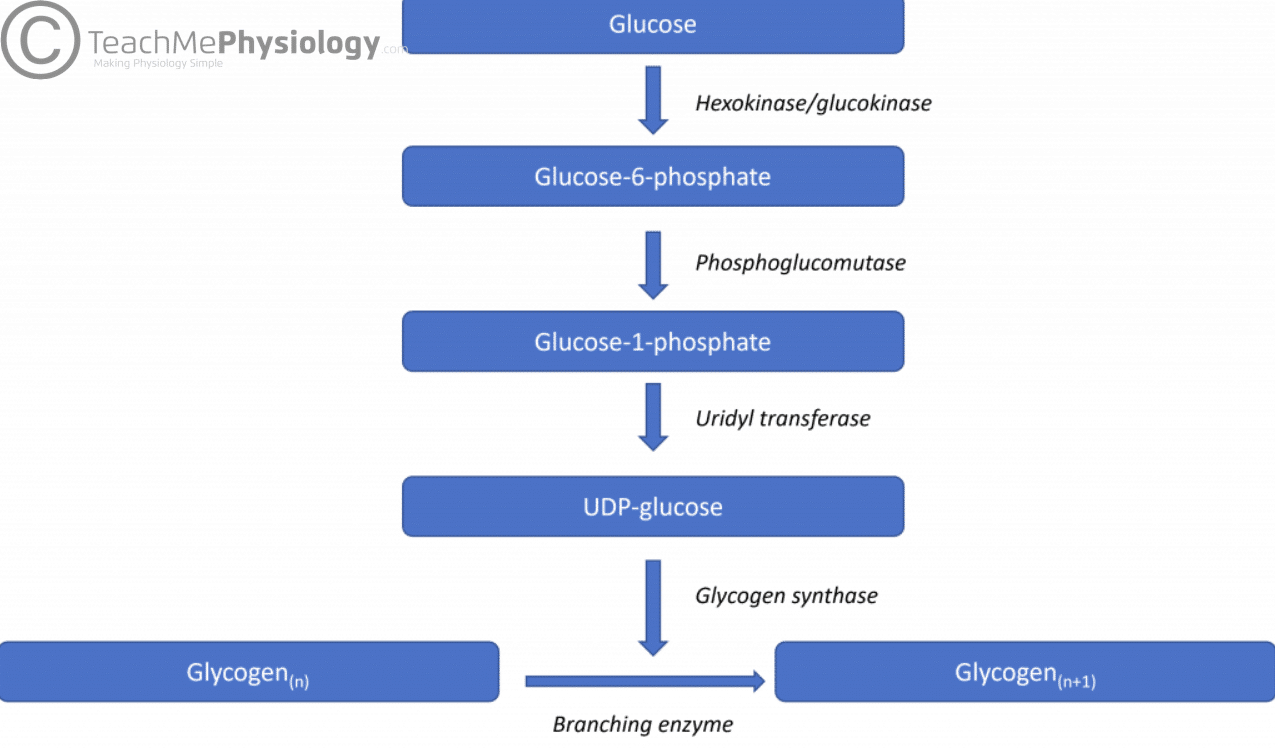The liver is the second largest organ in the body (after the skin) and has a variety of important functions relating to metabolism and detoxification. Information on the anatomy of the liver can be found here.
This article will look into the metabolic role of the liver with respect to carbohydrates, in particular glycogen.
Glycogen Metabolism
The liver plays a central role in maintaining steady blood glucose levels by converting excess glucose into glycogen through a process known as glycogenesis. Subsequently, when there is bodily demand for glucose, the glycogen can be converted back into glucose through a process known as glycogenolysis.
We will now consider these processes in more detail.
Glycogenesis
80% of the monosaccharide load absorbed by the small intestine is comprised of glucose, which is then delivered to the hepatocytes by the portal vein. Fructose and galactose are also absorbed, and the vast majority are immediately converted into glucose in the liver.
Once glucose is isolated in the hepatocyte, the following sequence of reactions occurs to synthesise glycogen:
- Glucose is converted to glucose-6-phosphate by glucokinase
- Glucose-6-phosphate is converted to glucose-1-phosphate by phosphoglucomutase
- Glucose-1-P is then converted to UDP-Glucose by uridyl transferase
- Finally, UDP-glucose is then added to the long glycogen chain within the liver cells by glycogen synthase, with assistance from branching enzyme
Glycogenolysis
Through glycogenolysis, glucose and glucose-6-phosphate are yielded from their storage in glycogen. It occurs within the cytosol of the liver and also within the cytosol of skeletal muscle. It is important to recognise that the sequence of reactions differs from glycogenesis and is not simply the reverse process.
- Firstly, a molecule of glucose is phosphorylated to remove it from the glycogen chain by glycogen phosphorylase (assisted by debranching enzyme) creating glucose-1-phosphate
- Glucose-1-phosphate is converted to glucose-6-phosphate by phosphoglucomutase
- Glucose-6-P is converted to glucose by glucose-6-phosphatase
Glucose-6-phosphate can also enter the glycolysis pathway at this point, which culminates in the formation of pyruvate.
The freed glucose is now ready for transport to other tissues where it will undergo glycolysis to produce pyruvate, which is then converted into Acetyl Co-A before entering the TCA cycle.
It is important to note that the metabolism of glycogen varies slightly between skeletal muscle and the liver. In the skeletal muscle, glucokinase predominates in place of hexokinase during the first steps of glycogenesis.
Regulation of Glycogenesis and Glycogenolysis
In order to avoid excessive and insufficient levels of blood glucose, the processes of glycogenesis require careful regulation. This is achieved primarily through allosteric and hormonal regulation.
Allosteric Regulation
The key regulatory enzyme in glycogenesis is glycogen synthase. Its activity is upregulated by high levels of glucose-6-phosphate.
In glycogenolysis, the key regulatory enzyme is glycogen phosphorylase. It is allosterically inhibited by high levels of ATP, glucose-6-phosphate and glucose.
Hormonal Regulation
Glucagon, adrenaline and insulin act via second messengers to control the rate and direction of glycogen metabolism.
Glucagon and adrenaline lead to upregulation of adenylate cyclase, which converts ATP into cAMP. cAMP then activates cAMP-dependent protein kinase, which phosphorylates glycogen synthase and glycogen phosphorylase.
Phosphorylation then leads to deactivation of glycogen synthase and activation of glycogen phosphorylase. Logically this makes sense, and glucagon and adrenaline are released as part of the sympathetic response to stress, and therefore it follows that the body will require more glucose at this point. Therefore, we need less glycogen (deactivation of synthase) and more free glucose (activation of phosphorylase)
Clinical Relevance – Glycogen Storage Diseases
Glycogen storage diseases are a variety of conditions caused by an absence/deficiency of the enzymes of glycogen metabolism, as described above. Generally speaking, these patients present with muscle cramps, hypoglycaemia and impaired physical development.
Von Gierke’s disease is the most common, which is a deficiency in glucose-6-phosphatase. These patients present with lactic acidosis, hypoglycaemia, hyperuricaemia and hepatic enlargement.

